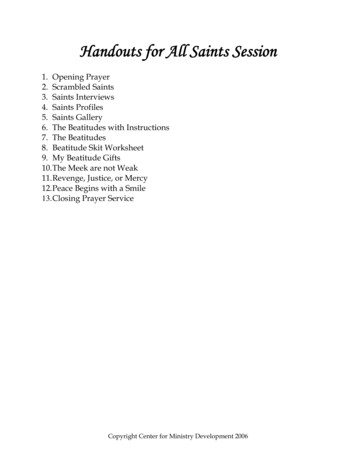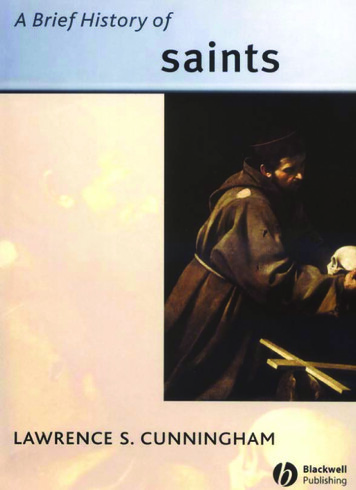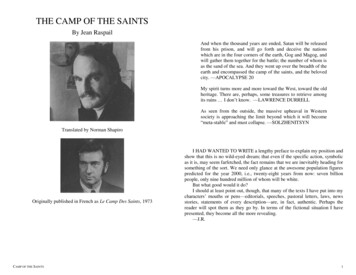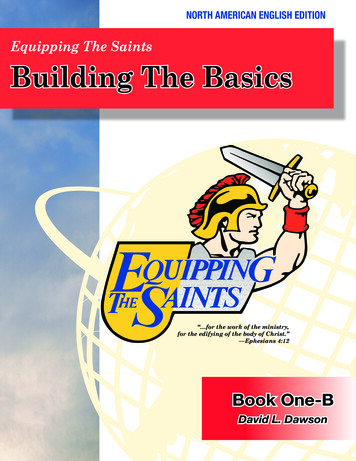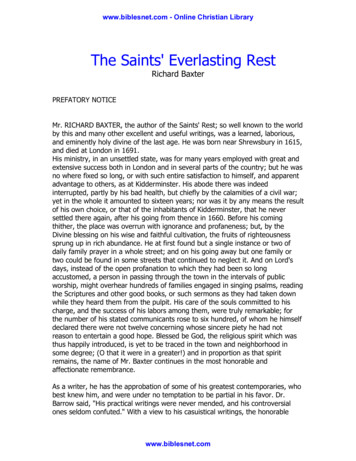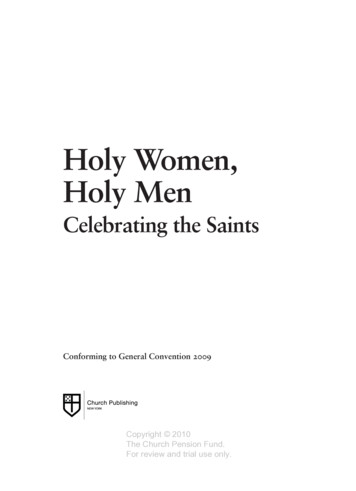
Transcription
Color profile: DisabledComposite Default screenFor All the AlltheSaints\ForAlltheSaints.vpFriday, September 28, 2007 1:36:20 PM1
Color profile: DisabledComposite Default aints\ForAlltheSaints.vpFriday, September 28, 2007 1:36:20 PM2
Color profile: DisabledComposite Default screenFor All the SaintsPrayers and Readings for Saints’ DaysAccording to the Calendar of theBook of Alternative Services of theAnglican Church of CanadaRevised with an Appendix includingRecent Additions to the Calendarcompiled byStephen eSaints\ForAlltheSaints.vpFriday, September 28, 2007 1:36:20 PM3
Color profile: DisabledComposite Default screenABC Publishing, Anglican Book CentreGeneral Synod of the Anglican Church of Canada80 Hayden Street, Toronto, Ontario, Canada M4Y hing.com www.pathbooks.comCopyright 2007, General Synod of the Anglican Church of CanadaAll rights reserved. No part of this book may be reproduced, stored in a retrievalsystem, or transmitted, in any form or by any means, electronic, mechanicalphotocopying, recording, or otherwise, without the written permission of the AnglicanBook Centre.Canadian Cataloguing in Publication DataMain entry under title:For all the Saints : prayers and readings for Saints’days : a supplement to the Book of alternativeservicesIncludes bibliographical references and index.10-digit ISBN 1-55126-502-813-digit ISBN 978-1-55126-502-51. Saints – Prayer-books and devotions – English.2. Anglican Church of Canada – Prayer-books anddevotions. 3. Anglican Communion – Prayer-books anddevotions – English. I. Reynolds, Stephen James,1951- . II. Anglican Church of Canada. Doctrineand Worship Committee. Calendar EditorialSub-Committee.EX5616.A432 rAlltheSaints\ForAlltheSaints.vpFriday, September 28, 2007 1:36:20 PMC92-093995-34
Color profile: DisabledComposite Default screenTable of ContentsForeword 7Preface9Introduction 11Suggestions for Using this Book20THE CALENDAR OF THE CHURCH YEAR23THE PROPERS FOR SAINTS’ DAYS 37with Biographical NoticesREADINGS FROM THE WRITINGS OF THE SAINTSand Supplementary NoticesAcknowledgements 775Appendix (recent additions to the Calendar)Index ts\ForAlltheSaints.vpFriday, September 28, 2007 1:36:20 PM5779387
Color profile: DisabledComposite Default aints\ForAlltheSaints.vpFriday, September 28, 2007 1:36:20 PM6
ForewordForewordIn every time and place God calls women, men, and children to holiness. This vocation, rooted in our baptism, is the summit of Christ’swork in us. In the commemoration of saints the Church celebratesChrist’s victory in the lives of particular individuals who haveinspired their own and succeeding generations.The commemoration of saints has always been a part of the Anglicantradition and has evolved over the centuries. The reformers of theXVIc. used the naive (and historically flawed) principle of biblicalliteralism to pare down the myriad commemorations they inheritedfrom the mediaeval calendars. Only those saints whose names couldbe found in scripture were celebrated liturgically. Other namesincluded in the calendar were largely for secular, rather than liturgical, use.Modern revision of Anglican Calendars can be dated from the publication of Walter Howard Frere’s Some Principles of Liturgical Reform(London, 1911) in which he suggested the addition of contemporarynames to future revisions of the Prayer Book. The Book of CommonPrayer (1962) adopted Frere’s suggestion and incorporated a largenumber of post-Reformation names in its Calendar. How these persons were to be commemorated liturgically, however, remainedunclear. Archbishop Harold Sexton’s The Canadian Book of OccasionalOffices (Toronto, 1964) provided liturgical material only for the preReformation entries, giving the curious impression that the Church’scommemoration of God’s call to holiness could not go beyond theXVIc. Further developments within Anglicanism — particularly workemerging from the Lambeth Conferences of 1958 and 1988 — established that it is both possible and permissible for Anglican churchesto commemorate the saints of every age, including our own. Furthermore, it is clear that the title “saint” may be applied to all those whoare included in Anglican Calendars.For All the Saints is intended to help enrich our celebration of thecommunion of saints in the Anglican Church of Canada. It has beenalmost twenty years in the making. Initially, Dean David Carter hadintended to produce a Canadian supplement to Lesser Feasts and Fastsof the Episcopal Church. The major reform of the Calendar to beincluded in the Book of Alternative Services made it clear that a muchlarger project was necessary in order to meet the needs of CanadianAnglicanism.In June of 1980, as Chair of the Calendar Sub-Committee of theNational Doctrine and Worship Committee, I asked Stephen Reynoldsto compile a work that would provide liturgical propers as wellForeword7
as a short biography that could be used within the liturgy for all theentries in the Calendar of the Book of Alternative Services. Neither henor I imagined the immensity of the task he agreed to undertake.This task was expanded when the committee decided to append fordevotional reading a number of texts from the writings of the saintscommemorated. Some of these appear in new translations made byDr. Reynolds from the Greek and Latin originals. Dr. Reynold’s contribution to the life of the Anglican Church of Canada is an importantone and needs to be recognized as such.The task of working through the proposed texts fell to the CalendarSub-Committee. Hundreds of hours were spent reading the textsaloud — so that they are as much for the ear as for the eye — andrefining them until the Committee felt that they would best serve theCanadian Church. The members of that committee — Tom Cain,John Hill, Maud McLean, Archie Skirving, Ansley Tucker, and KeithWhittingham — played a vital role in forming the present text and forthat also deserve the thanks of all those who will use this material.Finally, it is important to acknowledge the support of the NationalDoctrine and Worship Committee through the long gestation periodof this book and particularly Bishop Joachim Fricker who, as Chair ofthe Committee through the most creative part of the Sub-Committee’swork, gave us the courage to see the project to its end.David R. HoletonChair, Calendar Sub-Committee8Foreword
PrefacePrefaceFor All the Saints is a supplement to the Calendar of the Church Year, asprinted in The Book of Alternative Services (1985) and amended by GeneralSynod in 1989. It offers, in a single volume, a variety of resources for theobservance of those festivals which occur on fixed dates. This includesmost Principal Feasts and Holy Days as well as all Memorials and Commemorations.The present book has been more than ten years in the making. In theautumn of 1979 the Doctrine and Worship Committee of General Synodapproved a proposed revision of the Calendar of the Church Year. At thesame time, the Committee endorsed the preparation of a volume whichwould include proper prayers and readings, together with biographicalnotices, for each of the persons commemorated. This volume was to bemodelled on The Proper for the Lesser Feasts and Fasts, a publication of theEpiscopal Church of the United States. The Reverend Stephen Reynoldswas asked to compile such a volume.A first draft was presented to the Doctrine and Worship Committee in1981–1982. This draft subsequently underwent trial use by selected Anglican parishes and communities across Canada. In 1987 the Doctrine andWorship Committee established a Calendar Editorial Sub-committee andcharged it with the task of reviewing, revising, and preparing the document for publication. The members of this Sub-committee were: ProfessorTom Cain, the Reverend John W. B. Hill, the Reverend Professor David R.Holeton (chair), Mrs Maud McLean, the Reverend Dr Stephen Reynolds,the Reverend Dr A. H. Skirving, the Reverend M. Ansley Tucker, and theReverend Keith Whittingham.The Calendar Editorial Sub-committee clarified or developed a number ofguidelines for the present work.Proper Prayers. In the past, proper prayers for saints’ days usually havebeen so generic in content that it often made little difference whosename was inserted. Lesser Feasts and Fasts established the principle that“each Collect be distinctive of the person commemorated, or of thataspect of the Church’s life to which that person contributed most significantly.” For All the Saints strives to continue this principle and to apply itnot only to the Collects but also to the Prayers over the Gifts and thePrayers after Communion.Biographical Information. True celebration of the saints requires informedremembrance of their lives. Therefore, following the example of LesserFeasts and Fasts, the present work provides a biographical notice for eachperson commemorated. The Calendar Editorial Sub-committee has aimedat making these notices succinct enough to be contained on a singlepage, but with sufficient detail to give a real sense of why the Churchcommemorates that person. The Sub-committee has also been consciousthat the notices may be read aloud, and heard, in the liturgical assembly.With this in mind, the short biographical notices have been carefullyPreface9
edited so that they may be spoken easily, and readily understood by thelistening ear.Format. Celebration is encouraged if the chief resources for commemoration are immediately accessible. Lesser Feasts and Fasts places the propersof the day and the accompanying biographical notice on facing pages.This practice has been followed in For All the Saints.Inclusivity. Special attention has been paid to inclusive language in theproper prayers and in the biographical materials. This policy has beenapplied to language about divinity as well as to language about humanity. The proper prayers, in particular, attempt to explore a wider, moreinclusive range of images when addressing God. Traditional names andtitles — for instance, “Almighty God,” “Lord,” “Father” — have certainlybeen retained. But other, more experimental styles have also beenemployed.Non-Scriptural Readings. The persons commemorated in our Calendarhad important things to say to the Church of their day, or prompted contemporaries and later generations to reflect upon the meaning of theirlives in light of the gospel. To allow a closer acquaintance with individualsaints, therefore, For All the Saints includes a section entitled, “Readingsfrom the Writings of the Saints,” which offers non-scriptural Readings formost of the festivals in this book. These Readings are drawn either fromthe writings of the person commemorated or from some other relevantsource. Not every festival has an entry in this section. In some cases nosuitable Reading was available; in other cases such a Reading would onlyhave repeated material already contained in the short notice accompanying the propers of the day.It should be noted that the non-scriptural Readings are selections, not complete works. To make the texts easier and less distracting to read, ellipsispoints have not been used to indicate omissions. This decision follows theusage of the International Commission on English in the Liturgy.Sources. The Proper Prayers and Readings for the Principal Feasts andHoly Days are taken from The Book of Alternative Services, and are usedhere by permission. The Propers for the Memorials and Commemorationswere either compiled from other sources or composed specially for thisbook. The non-scriptural Readings in the final section are drawn fromsources as diverse as their original authors. The compiler and the Calendar Editorial Sub-committee wish to express their appreciation to thosecopyright holders who have given permission for a particular text ortranslation to be used in this work.This book is offered to the people of the Anglican Church of Canada withthanksgiving to God for the lives of the saints, and with the hope that itwill help to enrich our common life in Jesus Christ.Toronto, The Conversion of Saint Paul, 199210Preface
Color profile: DisabledComposite Default screenIntroductionIntroductionWhenever we say the Apostles’ Creed, we confess our belief in “thecommunion of saints.” This term is rich in meaning and kaleidoscopicin its references. It can mean “the holy people of God,” the community of all who have been baptized into Christ Jesus. It can refer to theactivity which sustains the unity of God’s people, sharing in the bodyand blood of Christ. And it can refer to the activity which this book isdesigned to help — the commemoration of those extraordinaryChristians whom we call “saints.”The habit of remembering “the friends of God” has been one of thegreat delights of Christian people since the dawn of the Church. Thereason for this is neither fancy theology nor sub-Christian superstition. It is simply that the history of God’s mighty acts of salvation isalways a personal history. The Church believes that the divine purposeof justice, mercy, and love is revealed in the stories of particular persons. Indeed, it is through the stories of individual saints that theAlmighty renews and strengthens the witness of the whole community of “the holy people of God.” Thus, the Calendar of Saints ismeant to jog our memories, to remind us that today or tomorrow isthe heavenly birthday of someone whose faith, holy life, and witnessto Christ were so great in their own time that they continue to be acause for celebration by us in our time.The Witness of ScriptureIn the Old Testament, the great story-cycles about Abraham andJacob, Moses, Joshua, and King David are all acts of commemoration.Most of these stories are meant to generate wonder and awe; theycelebrate the power, wiliness, wisdom, or military prowess of Israel’sancestors. The idea that the people should follow their examples —though certainly present — is very much in the background.This began to change with the cycle of stories about the prophet Elijah(1 Kings 17–2 Kings 2). The Elijah cycle includes stories of theprophet’s prowess in working mighty signs and wonders, but theyare subordinate to stories which recognize Elijah as an example forthe rest of God’s people. He remained faithful even though, as hecomplained to God, “the people of Israel have forsaken your covenant, thrown down your altars, and slain your prophets with thesword” (1 Kgs 19.10). He bore witness to God’s justice “against theodds,” and so became a sign and model for Israel to do likewise.Commemorating Elijah was not only a matter of wonder and awe; itwas also a call to imitate his faithfulness.In a similar way, the story of the Maccabees (in the can\ForAlltheSaints\ForAlltheSaints.vpFriday, September 28, 2007 1:36:54 PM1111
commemorates their fierce resistance to pagan overlords and recountshow whole families perished rather than break the covenant. Suchstories were both a celebration of their wondrous faithfulness and acall for all Jews to go and do likewise.The same sort of commemoration is present in the New Testament.After all, the gospels themselves are stories which celebrate themighty acts of Jesus and call his disciples to follow the example ofhis great obedience. The pattern is continued in the book of Acts,especially in the dramatic story of Stephen’s martyrdom (Acts 6–7).Stephen’s faithfulness even at the cost of his life was recounted notonly to excite wonder in the faithful who heard the book of Acts, butalso to give them an example and a model to follow.The Ancient ChurchPersecution of the Church by the pagan Roman authorities reinforcedthis trend. Many thousands of Christians were put to death, often byvery gruesome means, because they refused to renounce Jesus Christ.The Church felt that these martyrs had been given a unique gift — thepower to imitate Christ’s passion and death in their own bodies. Forthis reason, the early Christians came to believe that the souls of themartyrs must already have entered the joys of heaven.A good example of what happened is the story told by the Christiansof Smyrna, a city on the Mediterranean coast of Asia Minor, after theirbishop Polycarp was martyred in A.D. 156. (We commemoratePolycarp on February 23.) The Roman authorities tried to cremate thebishop’s corpse, because they feared that the local Christians might“abandon the Crucified and begin to worship this man.” In theiraccount of the episode, the Christians of Smyrna made it clear thatsuch a fear was utterly groundless:Little did they know that we could never abandon Christ, for itwas he who suffered for the redemption of those who are saved inthe entire world, the innocent one dying on behalf of sinners. Norcould we worship anyone else. For we reverence Christ as the Sonof God, whereas we love the martyrs as the disciples andimitators of the Lord, and rightly so because of their unsurpassedloyalty towards their king and master. May we too share withthem as fellow disciples!1To Christ alone they gave worship, but for the sake of Christ theydesired to give honour to his great martyr Polycarp. This distinctionled the Christians at Smyrna to an important decision. They not onlycollected Polycarp’s bones and ashes and buried them “in a fittingspot” outside the city walls. They also resolved to gather at the graveevery February 23, when12Introduction
we will be allowed by the Lord to celebrate the anniversary day ofPolycarp’s martyrdom, both as a memorial for those who havealready fought the contest and for the training and preparation ofthose who will do so one day.2The Christians of Smyrna continued to have fellowship with Polycarpby celebrating their eucharistic fellowship with Christ. To eat anddrink the eucharist was to share in the same banquet which Polycarpnow enjoyed in glory; and to have eucharistic table-fellowship withChrist was to have table-fellowship with all Christ’s true disciples inheaven and on earth.The church of Smyrna was not alone in its commemorative instinct.About the same time, quite independently, other churches began topay the same sort of honour to their own martyrs, often treating theanniversary of a martyr’s death as a festival equal to Easter and Pentecost. It was the martyr’s dies natalis, her or his birthday in heaven. Andjust as people held a party on the birthday of one of their family, sothe Church held a party on a saint’s dies natalis. They remembered themartyr by celebrating the eucharist, with prayers and scriptural readings appropriate to the occasion. This practice was the origin of thecycle of saints’ days which we know today.The Medieval ChurchEarly in the fourth century the Church was granted toleration, andwell before the close of the century Christianity became the established religion of the Roman empire. The faithful certainly continuedto celebrate the memory of those who had suffered during the time ofpersecution. But they also began to include others among the special“friends of God.” Monks and nuns, bishops, teachers of the faith, andmissionaries came to be honoured as saints.At the same time the commemoration of saints began to acquire a narrower focus. Church-people came to judge holiness more and more bya person’s reputation for working miracles. For the ability to performmiracles was a sign that the person in question was indeed a true“friend of God” — and therefore had influence in the heavenly courtof the almighty Emperor of the universe. Thus, Christians asked asaint to offer prayer in heaven and intercede with God on their behalf— a practice known as “the invocation of the saints.” The principlewas the same as when Christians ask for one another’s prayers — “Ihave an appointment with the doctor,” one might say to another, “saya prayer for me, will you?” In the case of invoking the saints, therewas of course one important difference. Because the saints were sohighly favoured by God and already beheld the divine gloryface-to-face, they had a far better chance of obtaining their requestsIntroduction13
from God than one’s next-door neighbour. One’s neighbours rarelyshowed any evidence of miraculous powers — and miracles were precisely what a saint’s intercession was supposed to obtain.By the Middle Ages, then, the saints were venerated chiefly asworkers of miracles; and miracles wrought at the tomb of a saint, orobtained by pleading for a saint’s intercession with God, were thebasic evidence necessary in the process of canonization. In the West,from the twelfth century onwards, this process was entirely in thehands of the Roman papacy. It came to involve several steps, in whichthe life and posthumous miracles of the proposed saint were subjectedto trial-like scrutiny.3The cult of the saints involved a number of assumptions about humanlife after death. First and foremost, it took for granted the distinctionbetween body and soul. The souls of the saints entered glory, whiletheir bodies remained buried on earth. But their earthly remains werestill believed to have a potent connection with their souls in heaven.The horizon of glory lay along their graves, and their physicalremains in shrines and under altars made the other world a next-doorneighbour in this world. The relics of the saints, it was thought, continued to embody the power of their personalities even after death;they were the “real presence” of the souls of “the friends of God” inheaven.Medieval theologians were well aware of the dangers which couldattend upon the cult of the saints. As a safeguard they developed thedistinction between latria, or the worship which is due to God alone,and dulia, the honour which may be given to humans who manifested,more fully than others, the image and likeness of God’s power anddominion. Nevertheless, the medieval Church found it difficult toresist the pious conviction that the saints represented approachablepower, whereas God’s power was inaccessible except through thesaints. This attitude led to a great irony. The emphasis on miraclestended to deprive the saints of power in another direction — thepower to act as examples for other Christians to follow. The prayersappointed for their feast-days rarely asked that “we” might follow“their” example, and the stories told about them were not designed toelicit imitation by fellow disciples but the sort of awe that clientsshould feel in the presence of a mighty patron.The Anglican CommunionIn the sixteenth century the cult of the saints came under fierceattack by the Protestant reformers. In their view, it violated the scriptural principle: “There is one mediator between God and humankind, Christ Jesus, himself human” (1 Tim 2.5). They also felt14Introduction
that, regardless of the theologians, the ordinary folk of the Churchwere not just honouring the saints but worshipping them. So, wherever they gained power, the Protestant reformers suppressed the cultof the saints. In England, for example, shrines were ransacked andbroken up, and the images of saints were systematically destroyed.This did not mean that Protestants rejected the whole concept of sainthood — on the contrary. But they did have difficulty when theysought an appropriate way to commemorate particular saints. Noreformed community struggled with this problem more than the sixteenth- and seventeenth-century Church of England.The first Prayer Book appeared in 1549, and its Calendar drasticallypruned the number of observable feast-days. In general, the onlyfestivals named and given proper collects and readings were thosewith warrant in the New Testament. The second version of the PrayerBook, which was published in 1552, relaxed the rule somewhat andincluded four non-biblical saints — George (April 23), Lammas Day(August 1), Laurence (August 10), and Clement of Rome (November23). In the Calendar, the New Testament feasts were printed in red inkand provided with proper collects and readings; the four non-biblicalfeasts were printed in black ink. This was the origin of the Anglicandistinction between “red letter days” and “black letter days.” In 1561Queen Elizabeth I issued a royal decree which added fifty-eight more“black letter” feasts to the Prayer Book Calendar; still more wereadded in 1604 and in 1662. These commemorations, however, werenever provided with propers or even commons to enable their observance.The early Prayer Books of our tradition presented commemoration asa twofold event. Nowhere was this expressed more clearly than in theEucharistic Prayer of the first Prayer Book (1549):And here we do give unto thee [Almighty God] most high praiseand hearty thanks, for the wonderful grace and virtue declared inall thy saints from the beginning of the world: And chiefly in theglorious and most blessed Virgin Mary, mother of thy Son JesuChrist our Lord and God, and in the holy patriarchs, prophets,apostles and martyrs, whose examples, O Lord, and steadfastnessin thy faith and keeping thy holy commandments, grant us tofollow.This petition balanced the two elements that we noticed in the secondcentury commemoration of Polycarp — a thanksgiving for God’swork in the lives of the saints, and a petition for grace to follow theirexamples and become similar vehicles of God’s working.Introduction15
Early Anglicans did not confine sainthood to figures from the NewTestament and the ancient Church. They also recognized saintsamong their own contemporaries. One of the most popular books inEngland, from its publication in 1563 well into the nineteenth century, was John Foxe’s Actes and Monuments of matters happening in theChurch, commonly called “Foxe’s Book of Martyrs.” In vivid proseand with a sure instinct for the dramatic, Foxe told the stories ofthose who had died for the Protestant faith during the reign ofQueen Mary I (1553–1558). He considered them martyrs and saints inthe strict sense and clearly wished them to be commemorated insome way. He even provided a Calendar in which each of themartyrs was assigned a day. The Church of England did not adoptthis Calendar, nor did it provide for the liturgical commemoration ofany of the Marian martyrs until this century. Nevertheless, theirstories entered the common consciousness of succeeding generationsand became a touchstone for what it meant to be Christian, Protestant,and English.The tradition continued into the seventeenth century and bore fruit ina crop of edifying biographies. The most famous of these works isIzaak Walton’s biographical quintet, published between 1640 and1678, The Lives of Dr John Donne, Sir Henry Wotton, Mr Richard Hooker,Mr George Herbert, and Dr Sanderson. Walton and other seventeenthcentury biographers presented their subjects as contemporary saintswho had lived godly Christian lives and borne loyal witness to “thesober principles and old establishment of the Anglican Church.”4Their stories proved very popular and kindled among the faithful agenuine affection for their memories. But again, the Church of England had no procedure for acknowledging its saints and giving themliturgical commemoration. This meant that, over two or three generations, the intention of Walton and the other biographers was frustrated. It was not for want of devotion, but for want of appropriatemeans to express that devotion, that the active remembrance of manyseventeenth-century saints eventually withered.Only at the beginning of this century, in fact, did Anglicans begin todo something about the commemoration of saints. In the yearsbetween the two World Wars many churches of the communionenriched their Calendars and began, for the first time, to commemorate post-Reformation names. Those same churches usuallysupported their reform of the Calendar by providing a Common ofSaints — sets of prayers and readings for “A Martyr,” “A Confessor,” “A Monk or Nun,” and so forth. In addition, local communities— parishes, deaneries, dioceses, and religious orders — began tosupplement the national Calendars with names of saints and heroes16Introduction
of the faith who were of special importance to them. The CanadianChurch was a leader in this respect. Its “draft proposed” Calendar of1955 — subsequently included (with a few additions and deletions) inthe 1962 Prayer Book — was hailed at the time as an outstanding contribution because its range of commemorations was both innovativeand balanced. Calendar reform was endorsed at the Lambeth Conference of 1958, and the churches of the Anglican communion have notlooked back since then. The Calendar of The Book of Alternative Servicesis one of the results of this communion-wide trend.Living with SaintsWhen the Church enrolls a person on its Calendar and commemoratesthat person in its liturgy, it does not make a saint where no saint hadexisted before. Instead, it recognizes a singular truth: God showedChrist specially at work in and through this person’s life, and therefore this person really was a saint all along. The Church’s decision tocommemorate a person is not a process of creation; it is a matter ofacknowledging what God has done, a question of discerning the storyof God as told in the story of a faithful human being. For this very reason, the saints are our examples on the way to the kingdom of heaven.Their stories are the signposts which Jesus, “the pioneer and perfecterof our faith” (Heb 12.2), has left to us who follow in faith.The Church honours the memory of many diverse individuals, and itgoes without saying that the story and example of each saint will notalways speak to everyone’s condition on every occasion. A couplecalled to married life is not expected to duplicate the example of amonk like Bernard or a nun like Hilda; nor is a p
For All the Saints Prayers and Readings for Saints’ Days According to the Calendar of the Book of Alternative Services of the Anglican Church of Canada Revised with an Appendix including Recent Additions to the Calendar compiled by Stephen Reynolds FAS-Revised-pgs1-6.prn 3 D:\Anglican\Fo
